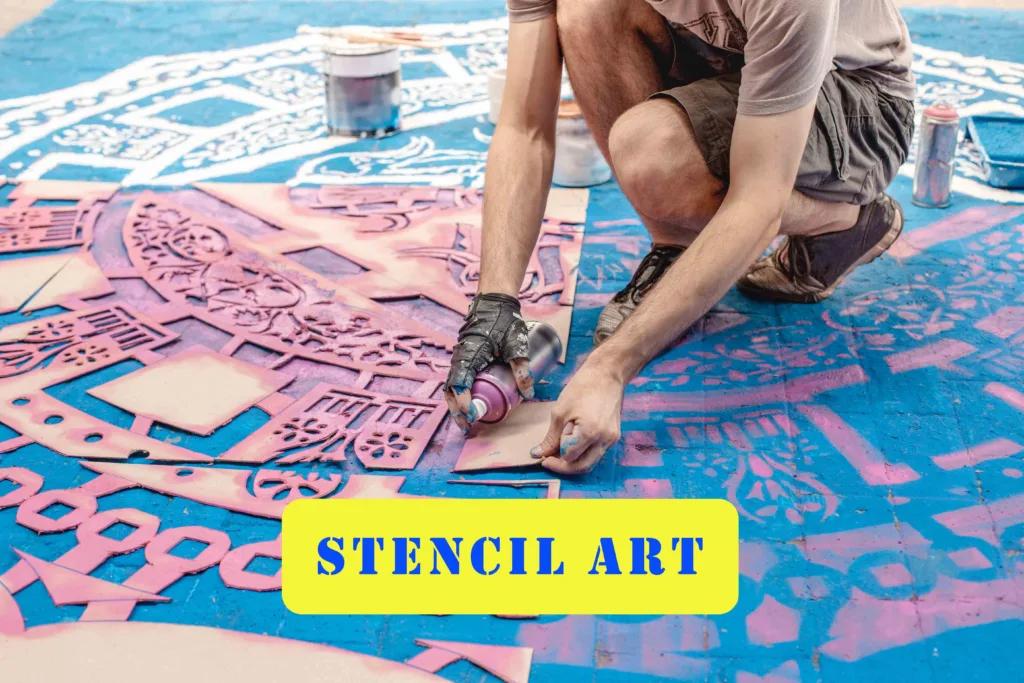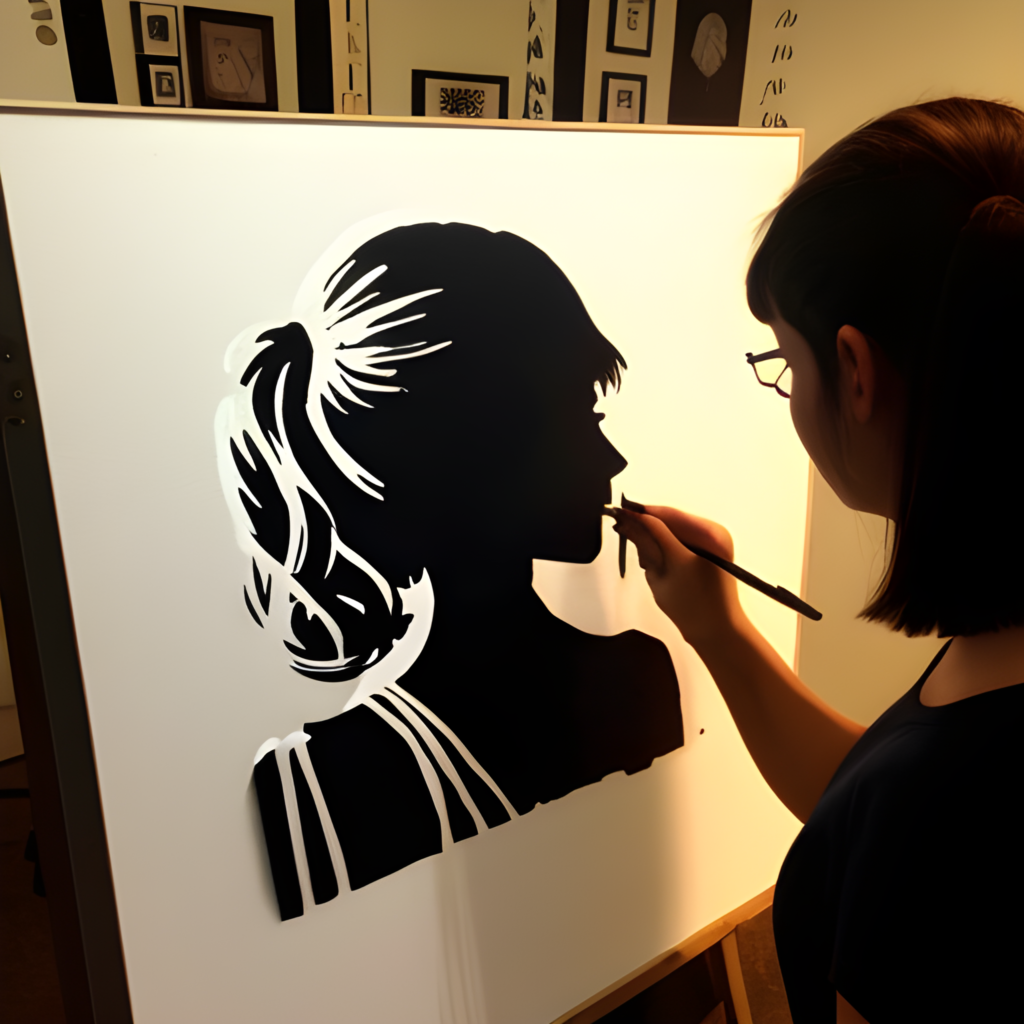In this growing world designers and artists evolved own skills and techniques also including grow and explore most frequent Art is a Stencil art it’s a form of artistic expression that is used for creating designs by cutting out shapes or patterns on a stencil material, allowing paint or ink to be applied through the stencil onto a surface. It is a technique often used in street art, modern walls in homes and providing a means to create bold and striking images. It involves the use of a stencil—a cut-out template—to create intricate designs on various surfaces. From street murals to interior decorations, stencil art has found its place in both traditional and contemporary art scenes. This article delves into the meaning, uses, benefits, types, history, origins, evolution, and modern techniques of stencil art, shedding light on the fascinating world of this unique art form.

Stencil art is a technique that utilizes a stencil which is like frame its use as a tool to designs something creative onto different surfaces. For creating the desired design on stencil, Artists are used materials like paper, plastic, or metal, etc. and now cut out patterns, shapes or images from a material then apply paint or ink over the stencil. Stencil art finds various applications, including:

Designers, artists and art enthusiasts having several benefits of using Stencil art lets discuss some of:

wide range of styles and techniques creates in Stencil art. let’s see some:

Stencil art has a great history it starts thousands of years ago and developed under in lots of cultures, Here’s a brief overview:

Stencil-like techniques were employed in ancient civilizations such as Egypt, China, and Japan. These early stencils were used for decorative purposes, textile production, and religious ceremonies.

Advancements in technology and artistic techniques have propelled stencil art into new frontiers. Here are some modern techniques and innovations in the field:

Stencil art has a rich history, diverse applications, and numerous benefits. From its ancient origins to contemporary innovations, stencil art continues to captivate audiences with its versatility and expressive potential. Whether on the streets or in galleries, stencilling serves as a powerful form of artistic communication, capable of conveying messages, inspiring emotions, and transforming spaces. this art form is most evolving form, its develops new techniques and technologies which is suitable for modern designers who is interest in stencils, Artists and enthusiasts continue to explore the possibilities, stencil art remains a vibrant and dynamic medium that resonates with audiences worldwide.
Ans: Yes, stencil art is considered a true art form. While definitions of art can vary, stencil art meets the criteria of artistic expression, creativity, and aesthetic value. It involves the deliberate use of stencils as a medium to create visual compositions, conveying emotions, ideas, or messages. Like other art forms, stencil art requires skill, technique, and artistic vision. Artists carefully design and cut stencils to achieve the desired image or pattern, considering factors such as composition, color, and texture. The process of selecting, positioning, and applying stencils onto various surfaces involves artistic decision-making and craftsmanship.
Furthermore, stencil art has a rich history and has been embraced by numerous artists, art movements, and cultural contexts. From ancient civilizations to contemporary street art, stencil techniques have been utilized to communicate personal, social, or political narratives. Artists like Banksy have elevated stencil art to a global platform, emphasizing its significance as a powerful means of expression.
legitimate of this Stencil art as a recognition of public spaces like galleries, museums. Its inclusion in the art world and its ability to captivate audiences demonstrate its artistic merit and relevance.
Additionally, stencil art offers a unique aesthetic experience. The use of stencils allows for precise, clean lines, bold imagery, and repetitive patterns that can create visually striking and thought-provoking artworks. The versatility of stencil art, its ability to be applied to various surfaces and materials, expands the possibilities for artistic experimentation and innovation.
stencil art is indeed a true art form. Its historical significance, artistic techniques, cultural impact, and aesthetic qualities all contribute to its recognition as a valid and valuable form of artistic expression.
Ans: In stencil art, various materials can be used to create the stencils and the artwork. The primary materials used in stencil art include:
1. Stencil Paper/Board: Stencil paper or stencil board is the base material on which the stencil design is created. It is usually a thin, durable material that can withstand repeated use.
2. Cutting Tools: Stencil art requires cutting out the desired design from the stencil material. Common cutting tools used include X-Acto knives, stencil knives, utility knives, or precision cutting tools. These tools allow for precise and clean cuts.
3. Stencil Film/Sheet: Stencil film or sheet is a transparent material that can be used to create more intricate and detailed stencils. It is often made of Mylar or acetate and allows artists to trace or draw their designs directly onto the film.
4. Spray Paint: Spray paint is the most common medium used to transfer the stencil design onto the desired surface. It comes in various colors and finishes and provides quick and even coverage.
5. Brushes and Rollers: In addition to spray paint, artists may also use brushes and rollers to apply paint onto the stencil. This can be useful for creating different textures, blending colors, or adding details to the artwork.
6. Masking Tape: Masking tape is used to secure the stencil onto the surface and prevent any paint from bleeding underneath. It helps create crisp and clean edges.
7. Stencil Adhesive: Stencil adhesive or spray adhesive can be used to temporarily adhere the stencil to the surface. This helps prevent any accidental movement or shifting while painting.
8. Protective Gear: When working with spray paint or any other potentially harmful materials, it is essential to wear protective gear such as gloves, goggles, and a respirator mask to ensure safety.
These materials are very commonly used in stencil art, some artists start to work with materials and techniques to make their artwork artistic on creative vision.
Ans: Banksy is the One of the most famous artists known for using stencils in their art. Banksy is a pseudonymous British street artist who rose to prominence in the early 2000s. He gained international recognition for his distinctive stencil-based artworks, often combining political and social commentary with a unique artistic style. Banksy’s stencils are designed by using multiple layers and arrange in convoluted manner, and they can be found in all over the globe. Banksy works for public and art enthusiasts alike; it is making him one of the most renowned stencil artists in our era.
Leave A Comment